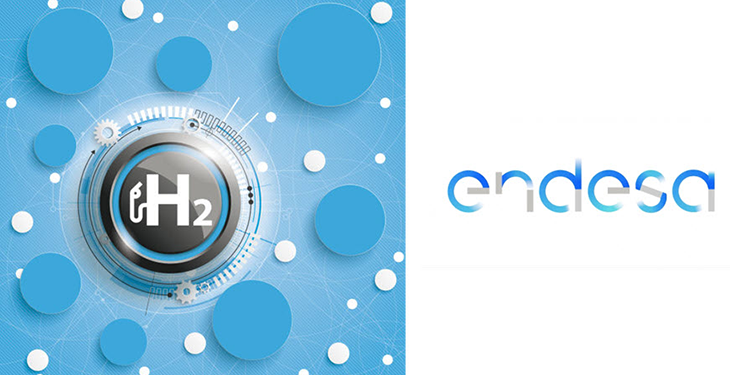Enel’s Spanish subsidiary Endesa has submitted a letter of interest to Spain’s Ministry of Ecological Transition to develop up to 23 green hydrogen projects in Spain, both on the Spanish mainland and in non-mainland areas. The investments associated with these projects, including the investment in the renewable plants that will power the electrolyzers, amount to approximately 2.9 billion euros. The projects cover different activities throughout the green hydrogen value chain, from production to consumption.
“Endesa wishes to emphasize its clear commitment to green hydrogen as a key element in the energy transition process and the decarbonization of the economy. These are objectives on which we have been working for years and which have marked our strategy of progressive replacement of conventional generation with renewable generation. The 23 green hydrogen projects that we are now presenting are associated with a power capacity of almost 2,000 MW of renewable energy,” said Endesa’s General Manager of Generation, Rafael González. “This capacity represents more than half of the 3,900 MW that the company has announced it will commission in Spain between 2021 and 2023, according to its updated strategic plan announced at the end of November 2020.”
The implementation of these projects will make a decisive contribution to achieving the objectives set for the first phase (2020-2024) of the Hydrogen Roadmap, launched by the Spanish government. All hydrogen production projects encompass investment in renewable generation plants dedicated to powering the electrolyzers. However, this is not exclusively the case, as they can also feed any surplus electricity generated into the grid.
Endesa is also committed to developing a national electrolyzer and equipment manufacturing industry associated with the implementation of its green hydrogen projects. This is another one of the strategic pillars included in the Hydrogen Roadmap.
Mainland projects
The most advanced project to date is the one underway in As Pontes (A Coruña), which will have a 100 MW electrolyzer and six associated wind farms, with an overall capacity of 611 MW, the construction of which is expected to create some 1,600 jobs during the 18 months of construction. The electrolyzer’s construction is due to take around 24 months, employing approximately 120 people. Over some 20 years, the electrolyzer’s operation and maintenance is expected to require the work of around 100 people. The total investment in the As Pontes project will reach 738.2 million euros. The complex is expected to produce 10,000 tons of green hydrogen and employ some 130 professionals in operation and maintenance work (100 in the electrolyzer and another 30 in the wind farms).
The aim of this first project is to show that a plant of this size can be built, operated and maintained from an economic as well as a technical and environmental perspective.
The rest of the mainland proposals (see Table 1) will be developed in Huelva, Teruel, Almeria, Tarragona, the Ebro Valley (Hidrógeno del Cierzo), Compostilla (Leon) and Seseña (Toledo). All together, they will involve an associated electrolyzer capacity of 215 MW, the creation of more than 500 jobs in the construction phase and around 220 more in the subsequent operation and maintenance phases.
The projects to be developed in mainland Spain bring a total of investment of 2 billion euros and electrolyzers with an aggregate capacity of 315 MW.
Non-mainland projects
For non-mainland projects (see Table 2), options include the production of energy with green hydrogen in new generation plants (Barranco de Tirajana, Granadilla and Alcudia, which will add electrolyzers totaling 25 MW), the changeover of operational plants to bi-fuel, and the replacement of power from other operational plants with hydrogen/gas.
The initiatives presented in the Canary Islands, Balearic Islands and Melilla come to 900 million euros in investment.
Overall, the 23 projects being proposed by Endesa are diverse in terms of their locations and the end uses of the hydrogen: they would be developed in areas of decarbonization and just transition, island energy generation systems, applications in the chemical industry, substitution of thermal consumption, and as a fuel for heavy transport. Their total production, once commissioned, is expected to amount to 26,000 tons of hydrogen per year.
Potential of green hydrogen
Renewable hydrogen will be a key energy carrier for the successful decarbonization of the energy sector. In particular, it will play an essential role in areas where electrification is not the most efficient solution or is not technically feasible in the medium term. Moreover, renewable hydrogen produced by electrolysis will contribute to the correct regulation of a 100% renewable electricity system, providing greater flexibility and improving the security of supply.
Nevertheless, renewable hydrogen production and consumption is still a nascent market, with a low degree of maturity. At present, only around 500,000 tons of hydrogen are produced and consumed in Spain as a raw material, almost entirely from fossil fuels, as this has not been a competitive option up to now.
In the expected context of falling renewable generation costs, rising CO2 prices and the need for seasonal energy storage, renewable hydrogen production technologies could become competitive for industrial uses in the coming years. In any case, support mechanisms to make the use of hydrogen competitive with other alternatives are still necessary at present to demonstrate its viability.
